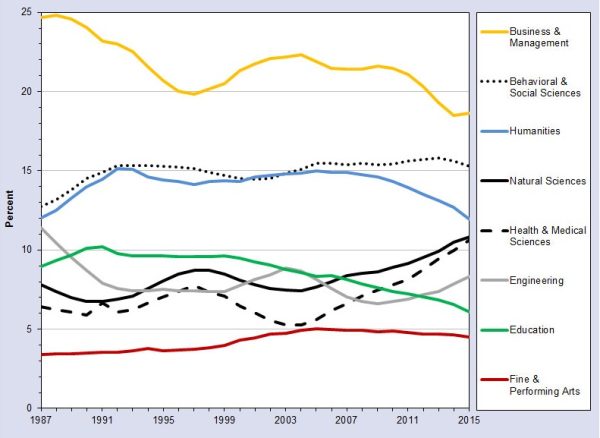Recently, the academic world has witnessed a shift in student values. With most students now preferring job security and salary over passion, the idea that STEM degrees, which are more likely to result in high-paying jobs, are more important than humanities degrees has risen in popularity.
According to data from Yale News, there were 259 more registrations in physical sciences and engineering classes than in humanities courses. This difference in course preference is not just seen at Yale—schools worldwide have reported their students taking more STEM classes. This, combined with the stigma associated with arts degrees, has led to a general consensus in academia that science or math studies are inherently more important or relevant than humanities.
There is no reason that humanities shouldn’t be held in the same regard as STEM—the skills and knowledge gained from studying arts and social sciences can be used to solve real-world problems. During the COVID-19 pandemic, journalists were essential for effectively distributing information and updates; psychologists and therapists were crucial for providing comfort during an isolated time.
Humanities-based majors are significant contributors to real-world sectors. Tourism is one of the world’s largest industries, with education graduates being responsible for maintaining our museums, historic sites, and galleries. Language studies contribute to social relations among nations and translation in everyday life where language barriers may be an issue.
While there is a very obvious salary difference between STEM and humanities—with STEM earning about $10,000-$30,000 more according to this student article—it should be noted that students who choose to pursue the latter are just as capable of succeeding as their science-oriented counterparts. While those with science, math, or engineering degrees may earn a greater initial salary, humanities students with a college-level education fare better in the long term.

One popular argument students tend to make is that since STEM subjects are more stressful or have a heavier workload, they are inherently more important. However, stress is not an effective way to measure success. Of course, it’s nearly impossible to avoid stress in college life, but a student should never strive to be overwhelmed, nor should they take pride in their suffering. Measuring importance by comparing stress levels creates an unhealthy environment for everyone—every subject has its challenges.
Additionally, the importance of interdisciplinary studies should not be ignored. When combined, STEM and humanities can accelerate our progress in fighting real-world problems. The World Economic Forum defines a “polycrisis” as a cluster of global risks with compounding parts—for example, the effect of climate change on migration or access to clean water. These types of problems can’t simply be solved by a single degree or specialty. To tackle these bigger issues, collaboration between both STEM and humanities graduates is vital.
Because of this, neither STEM nor the humanities should be considered more important than the other—both have their uses, challenges, and required skills. The artificial line we draw between the two is one that doesn’t exist for many successful people. Consider an innovator such as Leonardo da Vinci, who famously specialized in both science and the arts.
Rather than wasting our time discussing why one field should be deemed better, it’s much more productive to think of the benefits of overlapping different disciplines. Maybe, by gathering different people with different backgrounds and skills, we can address and solve some of the world’s most pressing issues.














